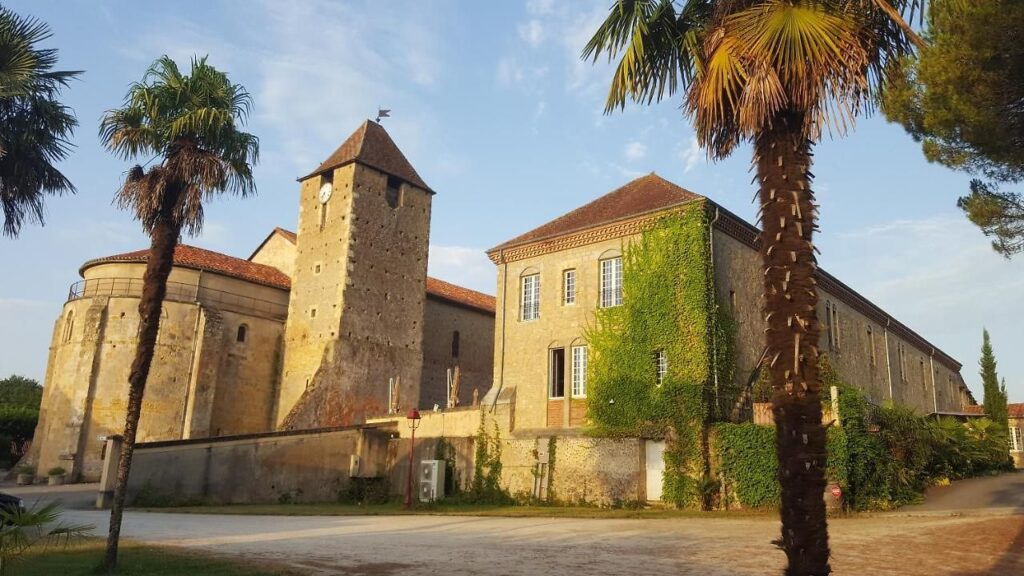The Madiran Priory :
A historical jewel in the heart of the Marie Maria Vineyard
Within the rich historical heritage of the Marie Maria vineyard is located an unknown treasure : the Madiran priory. This building, imbued with centuries of history, finds its roots in a distant era, around 1088, when this place of spirituality and culture was established in the dioceses of Tarbes.
The first steps of this institution hail from a detailed document found in the Madiran cartulary, preciously preserved in the Doat archives in the French national library.
This document, written with care, explains the foundation of the priory and the generous donations that came with it. Inside it we also discover the fascinating tale of Sautius, a knight of the noble lineage of the lords of Madiran, son of Garson who himself was son of Loup, nicknamed Picoth. Hailing from Spain, Sautius was the first to seek refuge in Madiran with permission from the county of Bigorre, Raymond, and actively participated in defending against enemies by the side of Garsie Arnaud, count of Bigorre.
This captivating tale transports us into the meanders of history, revealing how Sautius, after being accepted into religion by the abbot of Marcillac, contributed to the expansion of the Madiran monastery, notably by baptizing a church. Sautius’ efforts to liberate the monastery and the intrigues that followed it, notably through the transmission of his goods to the monastery and the struggles for its possession after his death, depict a vibrant image of medieval life.
Throughout the centuries, the Madiran priory has known periods of prosperity, but also times of turbulence. Significant figures such as Guillaume Par, Bernard and Eraclius, a bishop, left their imprint on its tumultuous history. Land disputes, power struggles and religious and civil authorities’ interventions punctuated this institution’s life. The Madiran priory’s history is a precious testimony of daily life, of beliefs and social dynamics of the medieval era. The documents found in the Madiran cartulary offer a fascinating window into this past so rich in surprises.

Today, the Madiran Priory still stands as a proud witness to a glorious past. Nestled within the enchanting Marie Maria vineyard, it continues to inspire and captivate visitors, transporting them to an era when knights and monks together shaped the destiny of this land.
Whether you’re a history enthusiast, a wine lover, or simply in search of beauty and authenticity, a visit to the Madiran Priory promises an unforgettable experience imbued with mystery and medieval grandeur.

Circa 1088 – Account of the Foundation of the Priory of Madiran in the Diocese of Tarbes, Including the Acts of Donations Made to Said Priory Contained in an Old Parchment Register Found in the Archives of the Jesuit Fathers in Toulouse, Who Held the Said Priory. These donations are undated, except for two, although the counts, archbishops, bishops, and other notable figures living at the time of the donations are named; the essence of the account and donations is marked by specific signs.
Account of the Foundation of the Priory of Madiran: It states that Sautius, a knight from the lineage of the Lords of Madiran and son of Garson, son of Loup (nicknamed Picoth), came from Spain and was the first knight to seek refuge in Madiran with the permission of Raymond, Count of Bigorre, who often repelled enemies alongside Garsie Arnaud, Count of Bigorre. After becoming consul of all Gascony, Sautius gained such renown that he received many visitors, including Étienne, abbot of Marcillac, who took him to his abbey and gave him the monastic habit. Upon returning to Madiran, Sautius enlarged the monastery, built a church, and then sought Ricard, bishop, and Garsie Arnaud, count, to ensure that the Lords of Madiran would grant freedom to the monastery. After gathering with neighboring knights and wise men, it was agreed that the count would grant Raymond Arnaud and Santius Arnaud, the principal lords of the area, an albergueof 50 knights, paid annually to him.
Years later, as Santius neared death, he summoned his cousin Bonus Par to declare that he had given the monastery and all its goods to the abbot of Marcillac. He instructed Bonus Par to renounce his wife, have his head shaved, and take the monastic habit at Marcillac, after which he would take possession of the monastery. Upon Santius’ death, Bonus Par sought to claim the monastery. With the help of his cousins, Bernard (count) and Eraclius (bishop), along with Aimeric, Count of Auch, Bernard, Count of Armagnac, Gaston, Count of Foix, and neighboring knights, they secured the freedom and safety of Madiran, swearing not to harm the place. When Bonus Par died, he left the monastery under the guidance of his son, Guillaume Par. Guillaume later acquired the tithes of the churches of St. Léon, St. Marie de la Grasse, and St. Michel de Sault, and killed Raymond Lupus de Lidos in a duel over the wood of Médiana, where he had built villages. However, Pons, bishop, and Centullus, count, learning of Guillaume’s misconduct, expelled him and replaced him with a certain Bernard, who bought the church of St. Michel de Hagedet from Étienne, its abbot.
Shortly after, Gombert, the fourth abbot of Marcillac after Étienne, remembered that Santius had given the monastery of Madiran to Étienne. Accompanied by Vinald, abbot of Moissac, and Guillaume, archbishop of Auch, Gombert showed the usurpation of Madiran in a full council where Bernard was present. Archbishop Guillaume consulted Pons, bishop of Bigorre, and thereafter, Gombert took possession of the monastery and appointed B… as its abbot.
Collection of 258 bound volumes. Copies of ancient documents concerning Guyenne and Languedoc. Copies made from 1664 to 1669 under the direction of Jean de Doat for Jean-Baptiste Colbert. This collection, acquired in 1732 by the Royal Library, is part of the “Collections on the History of Various Provinces.”